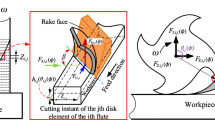Abstract
With the development of the aviation manufacturing industry, the application range of thin-walled parts is rapidly increasing. Accurate machining process and surface topography prediction are the keys to ensuring machining quality. This article is based on the relative geometric relationship between the real motion trajectory of the milling cutter and the workpiece; the undeformed chip thickness equation and the two-dimensional surface contour feature algorithm are established. By introducing the parameters of milling cutter critical height, milling cutter helix angle, and lag angle parameters, the three-dimensional surface profile prediction model and the equivalent three-dimensional model considering the chip formation process are derived. And the calculation equations of the instantaneous chip cross-sectional area and the blade-workpiece contact length of the three phases of chip formation are established, respectively. The multiple linear regression method was used to fit the orthogonal test results of titanium alloy Ti-6Al-4 V, so as to complete the dynamic milling force identification, and finally establish the milling force prediction model. The accuracy of the prediction model was verified by the single factor method, and the influence of different parameters on the milling process of thin-walled parts was observed. The results show that the established model has high accuracy in predicting the surface profile and milling force of thin-walled parts. This study provides guidance for efficient prediction of the milling process of thin-walled parts.













Similar content being viewed by others
References
Wan M, Zhang WH, Dang JW, Yang Y (2009) New procedures for calibration of instantaneous cutting force coefficients and cutter runout parameters in peripheral milling. Int J Mach Tools Manuf 49(14):1144–1151. https://doi.org/10.1016/j.ijmachtools.2009.08.005
Smaoui M, Bouaziz Z, Zghal A, Dessein G, Baili M (2011) Simulation of the deflected cutting tool trajectory in complex surface milling. Int J Adv Manuf Technol 56(5–8):463–474. https://doi.org/10.1007/s00170-011-3213-x
Li HZ, Liu K, Li XP (2001) A new method for determining the undeformed chip thickness in milling. J Mater Process Technol 113(1–3):378–384. https://doi.org/10.1016/S0924-0136(01)00586-6
Song G, Li JF, Sun J (2013) Approach for modeling accurate undeformed chip thickness in milling operation. Int J Adv Manuf Technol 68(5–8):1429–1439. https://doi.org/10.1007/s00170-013-4932-y
Kumanchik LM, Schmitz TL (2007) Improved analytical chip thickness model for milling. Precis Eng 31(3):317–324. https://doi.org/10.1016/j.precisioneng.2006.12.001
Liu X, Cheng K (2005) Modelling the machining dynamics of peripheral milling. Int J Mach Tools Manuf 45(11):1301–1320. https://doi.org/10.1016/j.ijmachtools.2005.01.019
Ma LJ, Gong YD, Chen XH (2014) Study on surface roughness model and surface forming mechanism of ceramics in quick point grinding. Int J Mach Tools Manuf 77:82–92. https://doi.org/10.1016/j.ijmachtools.2013.11.001
Ma LJ, Cai CY, Tan YQ, Gong YD, Zhu LD (2019) Theoretical model of transverse and longitudinal surface roughness and study on brittle-ductile transition mechanism for turning Fluorophlogopite ceramic. Int J Mech Sci 150:715–726. https://doi.org/10.1016/j.ijmecsci.2018.10.059
Tang XK, Zhao J, Zhang ZJ (2022) Model of cutting forces prediction for gear milling considering the three-dimensional undeformed chip thickness, penetration curve and working angles. Int J Adv Manuf Technol 118(5–6):1659–1671. https://doi.org/10.1007/s00170-021-07969-5
Pu XY, Liu WJ, Zhao JB (2010) Model of end milling force based on undeformed chip surface with nurbs in peripheral milling. Appl Mech Mater 33:356–362. https://doi.org/10.4028/www.scientific.net/AMM.33.356
Lu XH, Jia ZY, Wang FR, Li GJ, Si LK, Gao LS (2016) Model of the instantaneous undeformed chip thickness in micro-milling based on tooth trajectory. J Eng Manuf 232(2):226–239. https://doi.org/10.1177/0954405416639890
Zhou L, Peng FY, Yan R, Yao PF, Yang SS, Li B (2015) Analytical modeling and experimental validation of micro end-milling cutting forces considering edge radius and material strengthening effects. Int J Mach Tools Manuf 97:29–41. https://doi.org/10.1016/j.ijmachtools.2015.07.001
Qu SS, Yao P, Gong YD, Yang YY, Chu DK, Zhu QS (2022) Modelling and grinding characteristics of unidirectional C-SiCs. Ceram Int 48(6):8314–8324. https://doi.org/10.1016/j.ceramint.2021.12.036
de Oliveira FB, Rodrigues AR, Coelho RT, de Souza AF (2015) Size effect and minimum chip thickness in micromilling. Int J Mach Tools Manuf 89:39–54. https://doi.org/10.1016/j.ijmachtools.2014.11.001
Sun Y, Jin LY, Gong YD, Wen XL, Yin GQ, Wen Q, Tang BJ (2022) Experimental evaluation of surface generation and force time-varying characteristics of curvilinear grooved micro end mills fabricated by EDM. J Manuf Process 73:799–814. https://doi.org/10.1016/j.jmapro.2021.11.049
Altintas Y (2000) Modeling approaches and software for predicting the performance of milling operations at mal-ubc. Mach Sci Technol 4(3):445–478. https://doi.org/10.1080/10940340008945718
Budak E, Altintas Y, Armarego EJA (1996) Prediction of milling force coefficients from orthogonal cutting data. J Manuf Sci Eng 118(2):216–224. https://doi.org/10.1115/1.2831014
Rubeo MA, Schmitz TL (2016) Mechanistic force model coefficients: a comparison of linear regression and nonlinear optimization. Precis Eng 45:311–321. https://doi.org/10.1016/j.precisioneng.2016.03.008
Campatelli G, Scippa A (2012) Prediction of milling cutting force coefficients for Aluminum 6082–T4. Pro CIRP 1:563–568. https://doi.org/10.1016/j.procir.2012.04.100
Rafanelli F, Campatelli G, Scippa A (2015) Effects of cutting conditions on forces and force coefficients in plunge milling operations. Adv Mech Eng 7(6):1–9. https://doi.org/10.1177/1687814015589547
Brown M, Saoubi RM, Crawforth P et al (2022) On deformation characterisation of machined surfaces and machining-induced white layers in a milled titanium alloy. J Mater Process Technol 299:117378. https://doi.org/10.1016/j.jmatprotec.2021.117378
Schulz H, Moriwaki T (1992) High-speed machining. CIRP Ann Manuf Technol 41(2):637–643. https://doi.org/10.1016/S0007-8506(07)63250-8
Funding
This work was supported by the National Natural Science Foundation of China (U1908230).
Author information
Authors and Affiliations
Contributions
Conceptualization: Yadong Gong and Xiang Li. Methodology: Yadong Gong and Xiang Li. Resources: Yadong Gong and Jibin Zhao. Writing—original draft: Xiang Li.
Corresponding author
Ethics declarations
Ethics approval
The authors state that the present work is in compliance with the ethical standards.
Consent to publish
All authors agree to publish.
Consent for publication
The author agrees to publication in the Journal “Advanced Manufacturing Technology.”
Conflict of interest
The authors declare no competing interests.
Additional information
Publisher's note
Springer Nature remains neutral with regard to jurisdictional claims in published maps and institutional affiliations.
Rights and permissions
About this article
Cite this article
Li, X., Gong, Y. & Zhao, J. Surface profile and milling force prediction for milling thin-walled workpiece based on equivalent 3D undeformed chip thickness model. Int J Adv Manuf Technol 122, 977–991 (2022). https://doi.org/10.1007/s00170-022-09611-4
Received:
Accepted:
Published:
Issue Date:
DOI: https://doi.org/10.1007/s00170-022-09611-4



